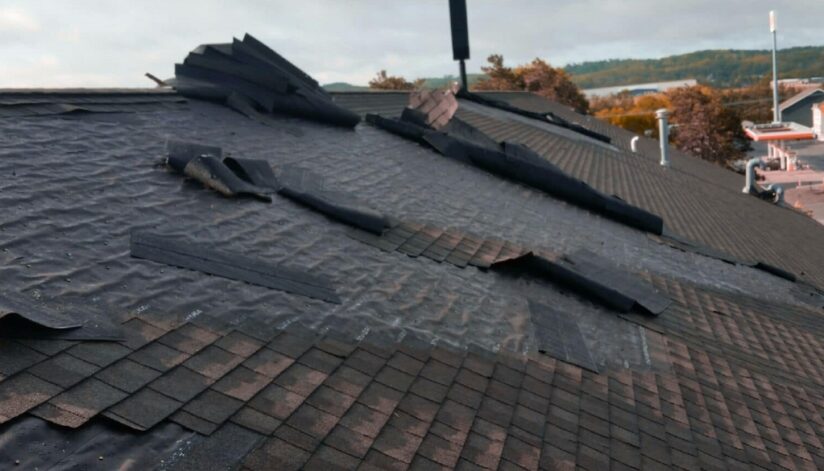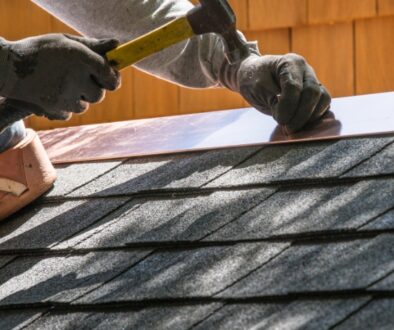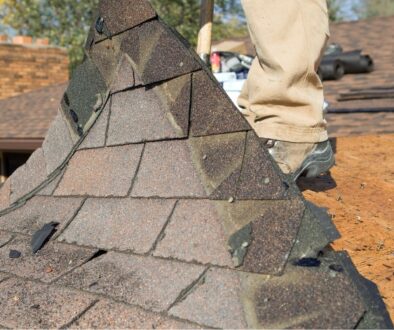How To Spot Roof Damage After Heavy Winds Or Rain
Late fall in Wisconsin often brings strong winds and heavy rain, both of which can wreak havoc on your roof. After a storm, it’s important to check for signs of roof damage to make sure your home remains safe and secure before winter’s harsher weather arrives. Here’s a step-by-step guide from our roofing experts at Ledegar Roofing to help you assess your roof for storm damage caused by heavy winds or rain.
Start With A Visual Inspection From The Ground
Before you grab a ladder or climb onto your roof, conduct a visual inspection from the ground. This step allows you to spot obvious signs of damage without risking your safety.
- Look for Missing Shingles: Heavy winds can easily tear shingles off your roof. Missing shingles appear as gaps in the pattern or patches of bare roof decking.
- Scan for Debris: Check for tree branches, leaves, or other debris on your roof. Large debris can damage shingles and underlying layers.
- Inspect the Gutters: Overflowing or sagging gutters may indicate clogs caused by debris or heavy rainfall.
Check For Storm Damage To Roof Features
Strong winds and heavy rain can also affect various components of your roof beyond the shingles.
- Flashing: Inspect the metal flashing around chimneys, skylights, and vents for signs of bending, rust, or detachment. Flashing is critical for preventing water from seeping into your home.
- Soffit and Fascia: Check the soffit (under the roof’s overhang) and fascia (the board along the edge of the roof) for cracks, holes, or loosened pieces.
- Vents and Chimneys: Make sure vents and chimneys are intact and free of obstructions. Wind can dislodge covers or caps, leaving your home vulnerable to leaks.
Look For Signs Of Water Damage Inside
Sometimes, storm damage isn’t immediately visible from the outside. Check the interior of your home for subtle signs that your roof may have sustained damage.
- Water Stains on Ceilings or Walls: Discolored patches or streaks on your ceiling or walls can indicate a roof leak.
- Damp Insulation: If you can access your attic, inspect the insulation for dampness or mold growth.
- Unpleasant Odors: Persistent musty odors may point to water intrusion in the roof or attic.
Examine Gutters And Downspouts
Gutters and downspouts are critical for channeling water away from your home, but they’re often overlooked during storm damage assessments.
- Check for Clogs: Heavy rain can wash debris into your gutters, causing blockages that lead to water overflow and damage.
- Inspect for Dents or Sagging: Wind and debris can dent or loosen gutters, reducing their effectiveness.
- Look for Granules: Shingle granules in your gutters or at the base of downspouts can signal roof wear or hail damage.
Use Caution When Climbing Onto The Roof
If you’re comfortable using a ladder, you may choose to inspect your roof more closely. However, always prioritize safety:
- Use a sturdy, properly secured ladder.
- Wear slip-resistant shoes.
- Avoid inspecting the roof in wet or icy conditions.
On the roof, look for:
- Cracked or Curling Shingles: Wind and rain can weaken shingles, causing them to crack, curl, or lift.
- Loose or Missing Nails: Exposed nail heads can let water seep into your roof, leading to leaks.
- Soft Spots: These could indicate areas where water has penetrated the roof decking, causing rot.
Document The Damage
If you notice any damage, take clear photos for documentation purposes. This will come in handy if you need to file an insurance claim or hire a professional roofer for repairs.
When To Call A Professional
While you can handle minor inspections on your own, it’s wise to call a professional roofer for a thorough assessment after severe weather. They have the expertise to identify hidden damage that could lead to bigger problems later.
- Persistent Leaks: If you find ongoing leaks or water stains, professional help is crucial.
- Structural Damage: Large debris, like fallen branches, can cause structural harm that needs immediate attention.
- Safety Concerns: If your roof appears unstable or you’re unsure about its condition, leave the inspection to an expert.
Prepare for Winter With a Healthy Roof
Spotting and addressing roof storm damage after heavy winds or rain is vital for preventing further issues, especially with winter just around the corner. By taking the time to inspect your roof and making necessary repairs, you can ensure your home stays warm, dry, and protected through Wisconsin’s cold months.
At Ledegar Roofing, we understand the challenges that Wisconsin weather can pose to your roof. If you’re in the Coulee Region and need a professional inspection or assistance with storm damage repairs, our experienced team is here to help. Contact us today to schedule an inspection and keep your home safe all season long.




